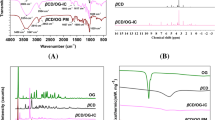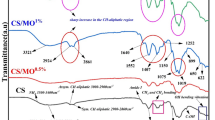Abstract
This study aimed to develop a bilayer film prepared by layer-by-layer solution casting method from polyvinyl alcohol (PVA) and shellac (sh). And the degradable antibacterial films (PVA@CMCS-CuO/Sh) were prepared with carboxymethyl chitosan-copper oxide nanoparticles (CMCS-CuO NPs) as the antibacterial agent in the PVA matrix. The chemical composition, morphological structure, mechanical properties, water resistance, antimicrobial property, and biodegradability of the composite films were also investigated. With the addition of CMCS-CuO NPs at 1, 2.5, and 5%, the water resistance of the films increased significantly, and the elongation at break (EAB) and tensile strength (TS) increased first and then decreased, and at 2.5% of CMCS-CuO NPs, the films had better mechanical properties and UV-blocking properties, and the inhibition rate of E. coli and S. aureus reached over 90%. Freshness tests on cherry tomatoes showed that PVA/Sh and PVA@CMCS-CuO/Sh films had a certain freshness retention effect, maintaining higher hardness and lower weight loss rate within two weeks. Degradation experiments showed a higher soil biodegradation rate of the bilayer films within 30 days. Compared with PVA films, PVA/Sh and PVA@CMCS-CuO/Sh films have superior antimicrobial activity and freshness preservation performance and have higher potential for food preservation applications.








Similar content being viewed by others
Data Availability
The data that support the findings of this study are available the corresponding author upon reasonable request.
Reference
Otoni CG, Avena-Bustillos RJ, Azeredo HMC et al (2017) Recent Advances on Edible Films Based on Fruits and Vegetables-A Review. Compre Rev Food Sci Food Safety 16:1151
Yu Z, Li B, Chu J, Zhang P (2018) Silica in situ enhanced PVA/chitosan biodegradable films for food packages. Carbohydr Polym 184:214
Kazemi SM, Rezaei M (2015) Antimicrobial Effectiveness of Gelatin-Alginate Film Containing Oregano Essential Oil for Fish Preservation. J Food Safety 35:482
Arfat YA, Ahmed J, Jacob H (2017) Preparation and characterization of agar-based nanocomposite films reinforced with bimetallic (Ag-Cu) alloy nanoparticles. Carbohydr Polym 155:382
Shankar S, Rhim J-W (2017) Preparation and characterization of agar/lignin/silver nanoparticles composite films with ultraviolet light barrier and antibacterial properties. Food Hydrocolloids 71:76
He X, Li M, Gong X, Niu B, Li W (2021) Biodegradable and antimicrobial CSC films containing cinnamon essential oil for preservation applications. Food Pack Shelf Life 29
Olewnik-Kruszkowska E, Gierszewska M, Jakubowska E, Tarach I, Sedlarik V, Pummerova M (2019) Antibacterial Films Based on PVA and PVA-Chitosan Modified with Poly(Hexamethylene Guanidine). Polymers 11
Suganthi S, Vignesh S, Sundar JK, Raj V (2020) Fabrication of PVA polymer films with improved antibacterial activity by fine-tuning via organic acids for food packaging applications. Appl Water Sci 10
Abdelhamied MM, Atta A, Abdelreheem AM, Farag ATM, El Okr MM (2020) Synthesis and Optical Properties of PVA/PANI/Ag Nanocomposite films. J Mater Sci-Mater Electron 31:22629
Atta A, Reheem AMA, Abdeltwab E (2020) Ion beam irradiation effects on surface morphology and optical properties of ZnO/PVA composites. Surface Rev Lett 27
Lotfy S, Atta A, Abdeltwab E (2018) Comparative study of gamma and ion beam irradiation of polymeric nanocomposite on electrical conductivity. J Appl Polym Sci 135
Yang W, Qi G, Kenny JM, Puglia D, Ma P (2020) Effect of Cellulose Nanocrystals and Lignin Nanoparticles on Mechanical, Antioxidant and Water Vapour Barrier Properties of Glutaraldehyde Crosslinked PVA Films. Polymers (Basel) 12
Shen Z, Rajabi-Abhari A, Oh K, Yang G, Youn HJ, Lee HL (2021) Improving the Barrier Properties of Packaging Paper by Polyvinyl Alcohol Based Polymer Coating-Effect of the Base Paper and Nanoclay. Polymers (Basel) 13
The DP, Debeaufort F, Luu D, Voilley A (2008) Moisture barrier, wetting and mechanical properties of shellac/agar or shellac/cassava starch bilayer bio-membrane for food applications. J Membrane Sci 325:277
Limmatvapirat S, Limmatvapirat C, Luangtana-Anan M et al (2004) Modification of physicochemical and mechanical properties of shellac by partial hydrolysis. Int J Pharmaceut 278:41
Li K, Zheng H, Zhang H, W-w Zhang K, Li JXu (2016) A novel approach to the fabrication of bleached shellac by a totally chlorine-free (TCF) bleaching method. Rsc Adv 6:55618
Bellan LM, Pearsall M, Cropek DM, Langer R (2012) A 3D Interconnected Microchannel Network Formed in Gelatin by Sacrificial Shellac Microfibers. Adv Mater 24:5187
Patel AR, Remijn C, A-iM Cabero PCM, ten Heussen JWMS, Hoorn KP Velikov (2013) Novel All-Natural Microcapsules from Gelatin and Shellac for Biorelated Applications. Adv Function Mater 23:4710
Li K, Tang B, Zhang W et al (2022) A novel approach for authentication of shellac resin in the shellac-based edible coatings: Contain shellac or not in the fruit wax preservative coating. Food Chemistry-X 14
Farag Y, Leopold CS (2011) Development of shellac-coated sustained release pellet formulations. Eur J Pharmaceut Sci 42:400
Abdelhamied MM, Abdelreheem AM, Atta A (2022) Influence of ion beam and silver nanoparticles on dielectric properties of flexible PVA/PANI polymer composite films. Plastics Rub Compos 51:1
Sahin B, Alomari M, Kaya T (2015) Hydration detection through use of artificial sweat in doped- and partially-doped nanostructured CuO films. Ceram Int 41:8002
Sahu K, Choudhary S, Mohapatra S (2020) Fabrication of Au-CuO hybrid plasmonic nanostructured thin films with enhanced photocatalytic activity. Mater Res Bullet 123
Wang H, Gong X, Guo X et al (2019) Characterization, release, and antioxidant activity of curcumin-loaded sodium alginate/ZnO hydrogel beads. Int J Biol Macromol 121:1118
Wang H, Gong X, Miao Y et al (2019) Preparation and characterization of multilayer films composed of chitosan, sodium alginate and carboxymethyl chitosan-ZnO nanoparticles. Food Chem 283:397
Tan YM, Lim SH, Tay BY, Lee MW, Thian ES (2015) Functional chitosan-based grapefruit seed extract composite films for applications in food packaging technology. Materi Res Bullet 69:142
Kalaycioglu Z, Kahya N, Adimcilar V et al (2020) Antibacterial nano cerium oxide/chitosan/cellulose acetate composite films as potential wound dressing. Eur Polym J 133
Rezaei M, Pirsa S, Chavoshizadeh S (2020) Photocatalytic/Antimicrobial Active Film Based on Wheat Gluten/ZnO Nanoparticles. J Inorg Organometal Polym Mater 30:2654
Roy S, Rhim J-W (2019) Melanin-Mediated Synthesis of Copper Oxide Nanoparticles and Preparation of Functional Agar/CuO NP Nanocomposite Films. J Nanomater 2019
Li Y, Zhou Y, Wang Z, Cai R, Yue T, Cui L (2021) Preparation and Characterization of Chitosan-Nano-ZnO Composite Films for Preservation of Cherry Tomatoes. Foods 10
Kaygusuz H, Torlak E, Akm-Evingur G, Ozen I, von Klitzing R, Erim FB (2017) Antimicrobial cerium ion-chitosan crosslinked alginate biopolymer films: A novel and potential wound dressing. Int J Biol Macromol 105:1161
Zivanovic S, Li J, Davidson PM, Kit K (2007) Physical, mechanical, and antibacterial properties of chitosan/PEO blend films. Biomacromolecules 8:1505
Kavoosi G, Dadfar SMM, Purfard AM, Mehrabi R (2013) Antioxidant and antimicrobial properties of gelatin films incorporating carvacrol. J Food Safety 33:423
Wang Q, Feng Y, He M, Huang Y, Zhao W, Zhao C (2018) Thermoresponsive Antibacterial Surfaces Switching from Bacterial Adhesion to Bacterial Repulsion. Macromol Mater Eng 303
Al-Tayyar NA, Youssef AM, Al-Hindi RR (2020) Antimicrobial packaging efficiency of ZnO-SiO2 nanocomposites infused into PVA/CS film for enhancing the shelf life of food products. Food Pack Shelf Life 25
Rhim J-W, Wang L-F (2013) Mechanical and water barrier properties of agar/kappa-carrageenan/konjac glucomannan ternary blend biohydrogel films. Carbohydr Polym 96:71
Koosehgol S, Ebrahimian-Hosseinabadi M, Alizadeh M, Zamanian A (2017) Preparation and characterization of in situ chitosan/polyethylene glycol fumarate/thymol hydrogel as an effective wound dressing. Mater Sci Eng C-Mater Biol App 79:66
Zhang Y, Zhang Y, Zhu Z, Jiao X, Shang Y, Wen Y (2019) Encapsulation of Thymol in Biodegradable Nanofiber via Coaxial Eletrospinning and Applications in Fruit Preservation. J Agric Food Chem 67:1736
Rao KM, Suneetha M, Park GT, Babu AG, Han SS (2020) Hemostatic, biocompatible, and antibacterial non-animal fungal mushroom-based carboxymethyl chitosan-ZnO nanocomposite for wound-healing applications. Int J Biol Macromol 155:71
Fan L, Du Y, Zhang B, Yang J, Zhou J, Kennedy JF (2006) Preparation and properties of alginate/carboxyrnethyl chitosan blend fibers. Carbohydr Polym 65:447
Abboud Y, Saffaj T, Chagraoui A et al (2014) Biosynthesis, characterization and antimicrobial activity of copper oxide nanoparticles (CONPs) produced using brown alga extract (Bifurcaria bifurcata). Appl Nanosci 4:571
Mallakpour S, Mansourzadeh S (2017) Application of CuO nanoparticles modified with vitamin B-1 for the production of poly(vinyl alcohol)/CuO nanocomposite films with enhanced optical, thermal and mechanical properties. Polym Adv Technol 28:1823
Abdeltwab E, Atta A (2021) Influence of ZnO nanoadditives on the structural characteristics and dielectric properties of PVA. Int J Modern Phys B 35
Selvi J, Mahalakshmi S, Parthasarathy V et al (2019) Optical, thermal, mechanical properties, and non-isothermal degradation kinetic studies on PVA/CuO nanocomposites. Polym Compos 40:3737
Abdelhamied MM, Atta A, Abdelreheem AM, Farag ATM, El Sherbiny MA (2021) Oxygen ion induced variations in the structural and Linear/Nonlinear optical properties of the PVA/PANI/Ag nanocomposite film. Inorg Chem Commun 133
Abdeltwab E, Atta A (2022) Structural and electrical properties of irradiated flexible ZnO/PVA nanocomposite films. Surf Innov 10:289
Byun Y, Ward A, Whiteside S (2012) Formation and characterization of shellac-hydroxypropyl methylcellulose composite films. Food Hydrocolloids 27:364
El Sayed AM, El-Gamal S, Morsi WM, Mohammed G (2015) Effect of PVA and copper oxide nanoparticles on the structural, optical, and electrical properties of carboxymethyl cellulose films. J Mater Sci 50:4717
Luangtana-anan M, Nunthanid J, Limmatvapirat S (2010) Effect of Molecular Weight and Concentration of Polyethylene Glycol on Physicochemical Properties and Stability of Shellac Film. J Agric Food Chem 58:12934
Du Y, Wang L, Mu R et al (2019) Fabrication of novel Konjac glucomannan/shellac film with advanced functions for food packaging. Int J Biol Macromol 131:36
Luangtana-anan M, Soradech S, Saengsod S, Nunthanid J, Limmatvapirat S (2017) Enhancement of Moisture Protective Properties and Stability of Pectin through Formation of a Composite Film: Effects of Shellac and Plasticizer. J Food Sci 82:2915
Park J-J, Lee J-G, Kim D-Y et al (2012) Antibacterial and Water Purification Activities of Self-Assembled Honeycomb Structure of Aerosol Deposited Titania Film. Environ Sci Technol 46:12510
Guo C, Guo H (2022) Progress in the Degradability of Biodegradable Film Materials for Packaging. Membranes 12
Ghoshal S, Khan M, Gul-E-Noor F, Khan R (2009) Gamma Radiation Induced Biodegradable Shellac Films Treated by Acrylic Monomer and Ethylene Glycol. J Macromol Sci Part A 46:975
Acknowledgments
The work was financially supported by National Natural Science Foundation of China (31700689), Natural Science Foundation of Shanxi Province (201901D111115), Transformation of Scientific and Technological Achievements Programs of Higher Education Institutions in Shanxi (2020CG015), Key Technology Research and Development Plan of Jinzhong City in Shanxi (Y201022), Liuweizhai Food Research Institute (213020310-J).
Author information
Authors and Affiliations
Corresponding author
Ethics declarations
Ethical approval
Did not involve human tissue experiments
Conflict of interests
The authors declare that they have no known competing financial interests or personal relationships that could have appeared to influence the work reported in this paper.
Additional information
Publisher's Note
Springer Nature remains neutral with regard to jurisdictional claims in published maps and institutional affiliations.
Supplementary Information
Below is the link to the electronic supplementary material.
Rights and permissions
Springer Nature or its licensor (e.g. a society or other partner) holds exclusive rights to this article under a publishing agreement with the author(s) or other rightsholder(s); author self-archiving of the accepted manuscript version of this article is solely governed by the terms of such publishing agreement and applicable law.
About this article
Cite this article
Wang, L., Gang, X., Xiao, Y. et al. Preparation of composite films composed of polyvinyl alcohol, shellac and carboxymethyl chitosan-CuO nanoparticles and their application in food preservation. J Polym Res 30, 63 (2023). https://doi.org/10.1007/s10965-023-03438-7
Received:
Accepted:
Published:
DOI: https://doi.org/10.1007/s10965-023-03438-7




